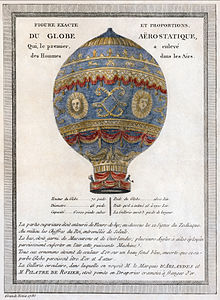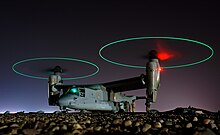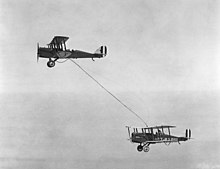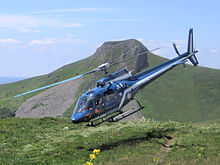Wikipedia:Wikipedia Signpost/2011-06-13/WikiProject report
WikiProject Aircraft







This week, we took flight with WikiProject Aircraft. The project was started by Cabalamat in September 2003 and has grown to include 14,000 pages. Among these are 5 featured articles, 7 A-class articles, and 64 good articles. The project's scope includes individual famous aircraft, aircraft types, aircraft engines, and related technology. WikiProject Aircraft is a child of WikiProject Aviation (see our August 2010 interview) and sibling of WikiProject Airlines and WikiProject Airports. WikiProject Aircraft contributes to the Aviation, USAF, and RAF portals. We interviewed project members Nimbus227 and Ahunt.
Nimbus227 is an aircraft engineer and private pilot. WikiProject Aircraft seemed like a natural fit for him, although he is not a member of any other aviation projects. One of his favorite aircraft types is the Lockheed F-104 Starfighter, which he has researched for 30 years and collected many books, including original flight manuals. "It was a very advanced design for the early 1950s and the causes of its accident rate in German service are often misunderstood." He owns a share in a de Havilland Tiger Moth.
Ahunt has spent most of his life in aviation, including experience as a civil and military pilot, maintenance test pilot, aviation writer, and aviation association manager. He has an extensive aviation reference library of books and periodicals that he has collected since the 1960s, many of which have been handy when referencing articles. He finds it difficult to pick a favorite aircraft since he's flown more than 50 types of aircraft during his lifetime, although he acknowledges that most of his flying time is spent on UH-1Hs and UH-1Ns. Like Nimbus227, he is not a member of any other aviation projects, "as working on aircraft is busy enough, when you throw in engines, aviation museums, etc, too."
How does WikiProject Aircraft differ from WikiProject Aviation? In what ways do the two projects collaborate?
- Ahunt: WikiProject Aircraft is really a subset of WikiProject Aviation. The latter encompasses aircraft, but also other aviation subjects, such as airports and navaids. I have dabbled in those subjects occasionally when the need comes up.
- Nimbus227: WikiProject Aircraft deals with specific aircraft types and how they work (including engines and components) and WikiProject Aviation covers everything else including biographic articles for designers that I have occasionally created. The two projects overlap at times. Most aircraft editors are members of the aviation project and will direct questions or requests to the right place or deal with it themselves.
Have you been involved in any of the project's 5 featured articles, 7 A-class articles, and 62 good articles? Share with us some interesting experiences or lessons you've learned while improving aircraft articles.
- Nimbus227: Yes, I successfully nominated the Rolls-Royce Merlin article for featured article status in October 2009 and an earlier relative, the Rolls-Royce R in November 2009. The experience was quite exhausting and different for each engine. The Merlin, being a popular article was subject to many edits during the review process, often introducing basic errors. I had to ask very nicely on the talk page for this to be moderated, being very careful not to take over the article at the same time! The Rolls-Royce R was a relatively obscure aero engine even though it was used very successfully for the Schneider Trophy air races. An enthusiast had pasted in the contents of his dying private website, a lot of information needed referencing and as I researched it further I discovered that there was a lot more to the story so I added the missing facts. The 'R' article had been neglected and unlike the Merlin it was not subject to daily edits, I really enjoyed getting it up to scratch. I was very fortunate to have a great copy editor for both articles, Red Sunset, they would not have got the star without his input. Another article we tried to get through FAC was British European Airways Flight 548, a lot of work went into it but we gave up after two failed reviews. I personally felt that we would never please the reviewer. I spend much more time now working on stub or start class articles as it is easy to improve them markedly in a short time.
- Ahunt: No, I tend to avoid working on FAs and especially GAs. The FAs tend to be more political wrangling than article improvement and I prefer to research and write than get into lengthy discussions. Good Articles are an even bigger problem. I have seen articles put through the GA process and come out worse at the end, mostly due to the inflexible use of rules by people who don't necessarily understand the subject matter.
WikiProject Aircraft maintains one task force devoted to aero engines and aero-derivative engines. Have you had any part in this task force? Has the task force been successful in bringing attention to neglected articles on a major component of most aircraft?
- Nimbus227: Yes!! I set the task force up in December 2008 with the assistance of Rlandmann. There was a lot to do including categorisation, navbox creation and article improvement. There are around 1,400 articles that come under the task force's scope now and I think that there has been a vast improvement in Wikipedia's coverage of aero engines, very satisfying to see that.
- Ahunt: After Nimbus started the task force I signed up right away and remain a continuing participant. In many ways we split up the work and so I decided to take on the two-stroke aircraft engines because I have rebuilt and flown some of them and mainly because no one else was keen to do that niche area. In 2010 I managed to start articles on every two-stroke that I could find references for, so they are fairly complete now.
Does the project have any guidelines regarding military aircraft for which little information is publicly available? For example, how did the project handle coverage of the stealth helicopter used by United States Navy Seals in the recent mission to kill Osama bin Laden?
- Ahunt: It is strictly a matter of WP:RS, if they can be found then we can create articles. If not then they often don’t get done, rather than resort to speculation and hyperbole. The problem is that well-meaning fans tend to add this sort of information without refs, which requires follow-up work, but that is the nature of an open project.
- Nimbus227: I saw the discussion that I think resulted in the Stealth helicopter article but I tend to avoid subjects with little available information as editor speculation often creeps in, is removed, then added again! The Coandă-1910 is a prime example of this with several RfCs being raised although the problem there appeared to be conflicting sources and user bias.
In our interview with WikiProject Aviation last year, Bzuk noted that maintaining a consistent writing style and reference system in articles on various aviation topics has been difficult. Has WikiProject Aircraft had to deal with these inconsistencies? If so, what progress has been made?
- Nimbus227: Absolutely, consistency within articles is very important, it's quite difficult to correct it later to pass a featured article review, much better to get it right at an early stage. I would like to see more consistency of format across the project personally. We have Wikipedia guidelines and project guidelines but they are regularly ignored by some editors, this is either down to lack of knowledge of the guidelines or deliberate imposition of a personal favoured style (differing from one already established in an article). WP:CITEVAR is very clear that citation style should not be changed without good reason, Bzuk spends a lot of time pointing this out and I have as well in the past, it usually meets with a negative response though I have to say. I believe this is an ongoing problem which has a negative effect on editors who are trying to follow the guidelines. As a collaborative project we can only hope that members gradually acknowledge and accept the guidelines and abide by the spirit of them.
- Ahunt: While more consistency across articles is a good thing in an open project like Wikipedia, you do have to accept some style variations as part of the landscape, unless you are willing to re-write everything yourself. We do try to make sure that aircraft type articles conform to Wikipedia:WikiProject Aircraft/page content so that at least the page layout from one type article to another isn't totally bewildering for the casual reader.
What are the project's most pressing concerns? How can a new contributor help today?
- Nimbus227: Better referencing of existing articles would be a step forward, many articles have been tagged for better referencing for several years and others should be tagged where they have not been. There are long lists of missing articles that new contributors could help with creating but as the aircraft types get more obscure it gets more difficult to find specialised reference sources for them, in some cases there are no sources. These lists may not be as accessible as they could be for newcomers. More of a WikiProject Aviation problem perhaps than an aircraft project problem is the notability of air accidents. Many air accident articles are brought to AfD with notability concerns, to my knowledge WP:AIRCRASH is still just an essay but often gets quoted as a guideline, would be nice to put a lid on that problem.
- Ahunt: I agree that referencing is a big issue. Many articles have too much unreferenced text that may or may not be accurate. Much of it is added by aircraft type fans or even owners of aircraft types, but it still has to meet WP:V. It is much easier to add referenced text than try to later go back and find a ref for something that someone else added. Spam and Conflicts of Interest are another problem as advertising budgets for aircraft manufacturers got cut in the recent recession many company internal marketing departments and contract advertising companies saw Wikipedia as a great opportunity to get free advertising. There were some discussions about their attempts to remove all criticism and replace it with spammy marketing text on some aircraft type articles, but we always got it sorted out in the end, though collaboration on the project. Most companies that try to use Wikipedia like that are characterized by very heavy-handed and amateurish work using single purpose accounts and that makes it relatively easy to spot and fix, although they can be persistent.
Anything else you'd like to mention?
- Nimbus227: Some fairly high profile articles are poorly illustrated, either with few or no images or the existing ones are not particularly good, faded 'tourist snapshots' are creeping in to some articles. It takes effort to search for and upload non-free fair use images but it can be done, a picture paints a thousand words. As the Wikimedia Commons collection of images grows the chances are that better images will become available and I check in there occasionally to see if there are any new images. On the other side of the coin some articles are illustrated with far too many images, added in good faith by enthusiastic editors. They should be trimmed down, leaving only the best ones in place. The Rolls-Royce Limited article is a fantastic example of this and it has been like that for several years now, the article is supposed to be about the company that built many aero engine types as well as luxury cars (which are highly visible there!!).
- Ahunt: One of the biggest challenges the project has taken on is to complete the aircraft type articles on every type ever flown. With over 10,000 type articles you would think that we would be close by now, but my estimate is that we aren't even half way yet. The obvious aircraft types were written up long ago: Cessna 172, Piper Cherokee, Boeing 747. Those were easy to do because there are lots of references available and lots of editors interested in working on them. It is the more obscure types, the pioneering aircraft for example, that need articles started on them. I am often surprised when I come across a relatively well-known type and discover that there is no article in it at all. This is what lead me to start the DFS Weihe article on that legendary glider design and the UFM Easy Riser on the well-known pioneering ultralight. Since then I have been working on filling in the more obscure glider type articles, since I have the refs available. There seems to be a feeling amongst some new editors that all the aircraft articles are already written, but there are lots and lots that need starting. All you need is some references and the persistence of a keen researcher to track down the story of an aircraft type and start the article. Then you need to list it at Wikipedia:New articles (Aircraft) so that it can be reviewed and improved by other project members. It takes research and good refs to start an article, but it is collaboration that makes them better. In the end it is all about building the best and most complete encyclopedia for the readers.
Next week's project will provide an element of excitement. Until then, check out our periodically published articles in the archive.


Discuss this story